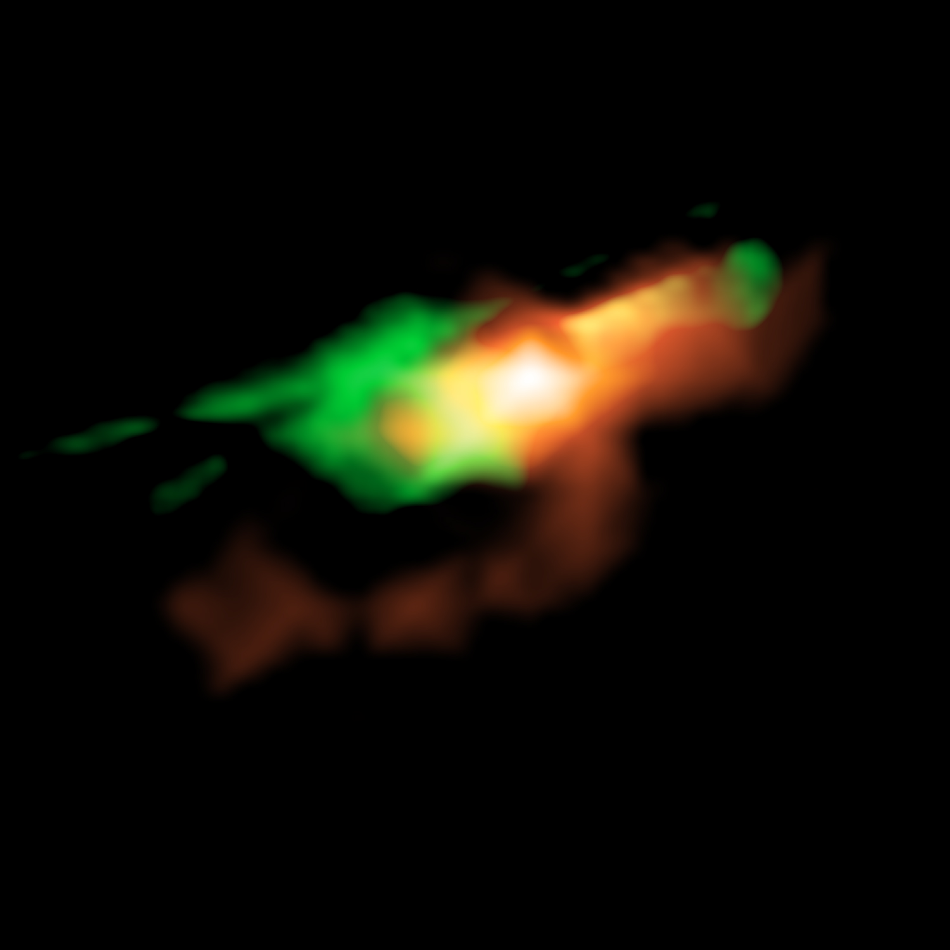Mar 30 2020
For the first time, astronomers have captured the resolved image of disturbed gaseous clouds in a galaxy located 11 billion light-years from Earth. They achieved this with the help of the Atacama Large Millimeter/submillimeter Array (ALMA).
 Reconstructed images of what MG J0414+0534 would look like if gravitational lensing effects were turned off. The emissions from dust and ionized gas around a quasar are shown in red. The emissions from carbon monoxide gas are shown in green, which have a bipolar structure along the jets. Image Credit: ALMA (ESO/NAOJ/NRAO), K. T. Inoue et al.
Reconstructed images of what MG J0414+0534 would look like if gravitational lensing effects were turned off. The emissions from dust and ionized gas around a quasar are shown in red. The emissions from carbon monoxide gas are shown in green, which have a bipolar structure along the jets. Image Credit: ALMA (ESO/NAOJ/NRAO), K. T. Inoue et al.
According to the study, the disruption is due to young, strong jets emitted by a supermassive black hole located at the center of the host galaxy. The study outcomes will offer insights into the evolutionary process of galaxies in the early Universe.
A widely known fact is that black holes exert powerful gravitational attraction on the matter surrounding them. But it is not commonly known that certain black holes contain rapid-moving streams of ionized matter, named jets. In some neighboring galaxies, evolved jets discharge galactic gaseous clouds, which suppress the formation of stars.
Thus, to gain better insights into the evolution of galaxies, it is vital to visualize the interaction between gaseous clouds and black hole jets through the entire cosmic history. But it had been quite challenging to acquire proper proof of such interaction, specifically in the early Universe.
The astronomers used ALMA to acquire such clear evidence, by visualizing an intriguing object called MG J0414+0534. A unique attribute of MG J0414+0534 is that the paths of light traveling from that object to Earth are considerably distorted under the influence of the gravity of another “lensing” galaxy between MG J0414+0534 and Earth. This leads to substantial magnification.
This distortion works as a ‘natural telescope’ to enable a detailed view of distant objects.
Takeo Minezaki, Associate Professor, University of Tokyo
Another attribute is that MG J0414+0534 includes a supermassive black hole containing bipolar jets and located at the center of the host galaxy. The astronomers could reconstruct the “true” image of gaseous clouds and the jets in MG J0414+0534 by carefully taking the gravitational effects of the intervening lensing galaxy into account.
Combining this cosmic telescope and ALMA’s high-resolution observations, we obtained exceptionally sharp vision, that is 9,000 times better than human eyesight. With this extremely high resolution, we were able to obtain the distribution and motion of gaseous clouds around jets ejected from a supermassive black hole.
Kouichiro Nakanishi, Project Associate Professor, National Astronomical Observatory of Japan/SOKENDAI
The excellent resolution of the observation enabled the researchers to find that gaseous clouds along the jets exhibit violent motion with speeds of nearly 600 km/second. This demonstrates the existence of impacted gas. Furthermore, it was found that the size of the jets and the impacted gaseous clouds are considerably smaller compared to the actual size of a galaxy of this age.
We are perhaps witnessing the very early phase of jet evolution in the galaxy. It could be as early as several tens of thousands of years after the launch of the jets.
Satoki Matsushita, Research Fellow, Academia Sinica Institute of Astronomy and Astrophysics
“MG J0414+0534 is an excellent example because of the youth of the jets,” noted Kaiki Inoue, a professor at Kindai University, Japan, and the lead author of the research paper describing this study, published in the Astrophysical Journal Letters.
Inoue concluded, “We found telltale evidence of significant interaction between jets and gaseous clouds even in the very early evolutionary phase of jets. I think that our discovery will pave the way for a better understanding of the evolutionary process of galaxies in the early Universe.”
This study was funded by JSPS KAKENHI (No. 17H02868, 19K03937), NAOJ ALMA Scientific Grant Number 2018-07A, and Ministry of Science and Technology (MoST) of Taiwan, MoST 103-2112-M-001-032-MY3, 106-2112-M-001-011, and 107-2119-M-001-020.